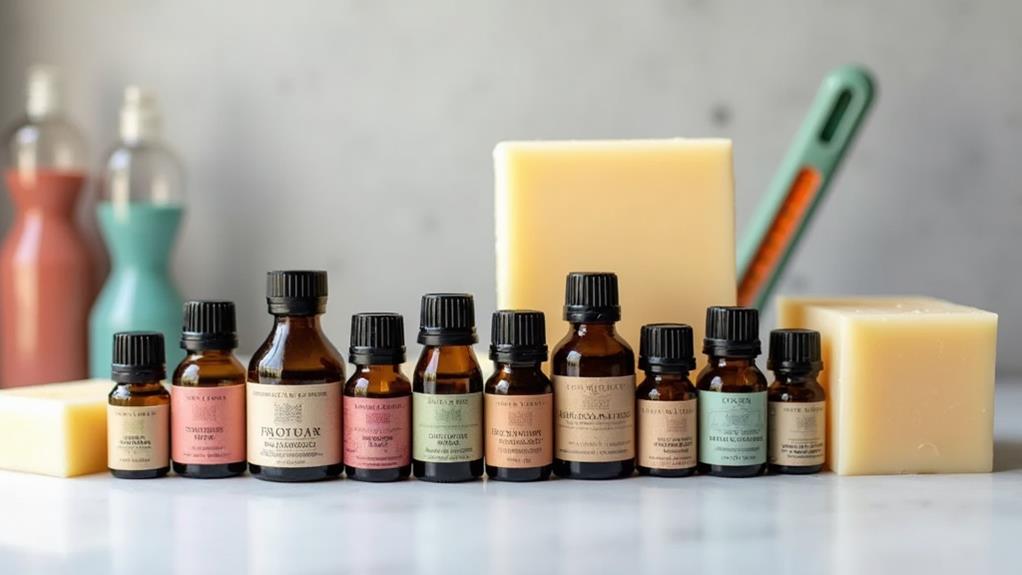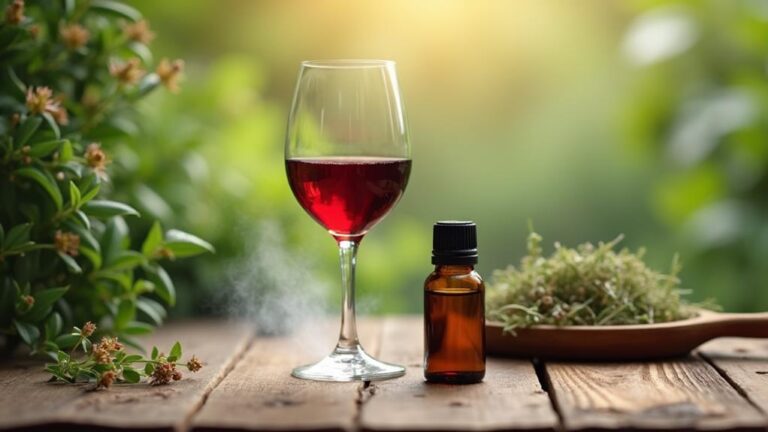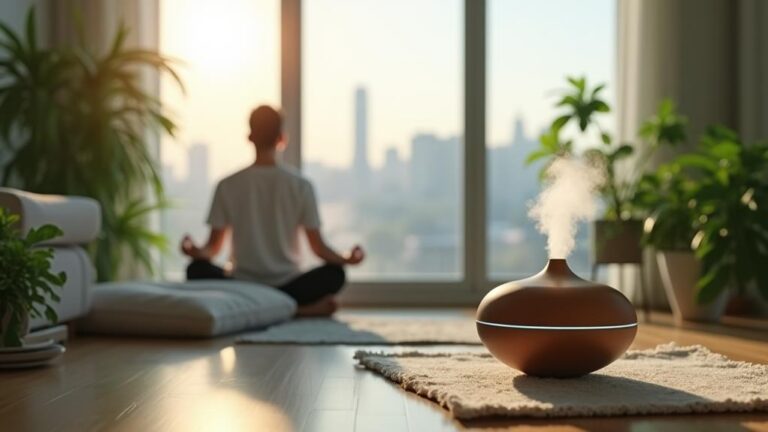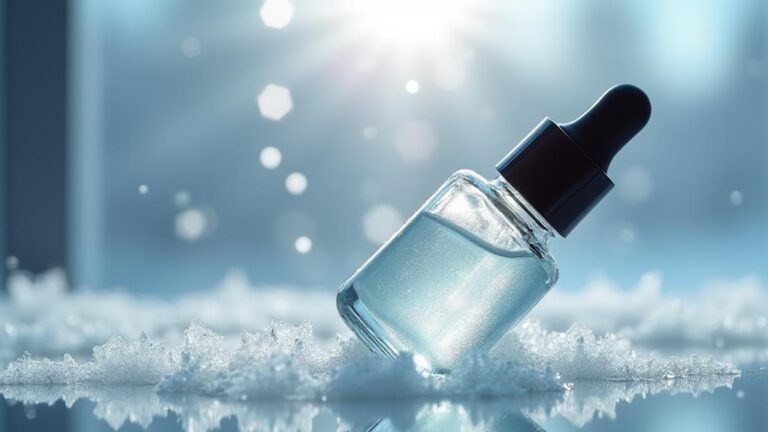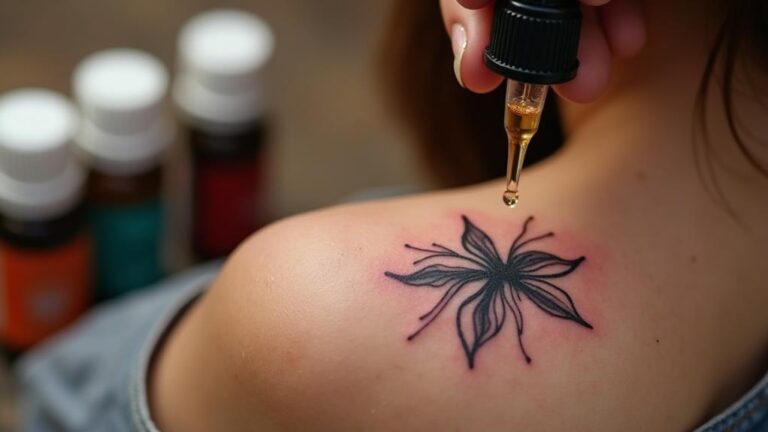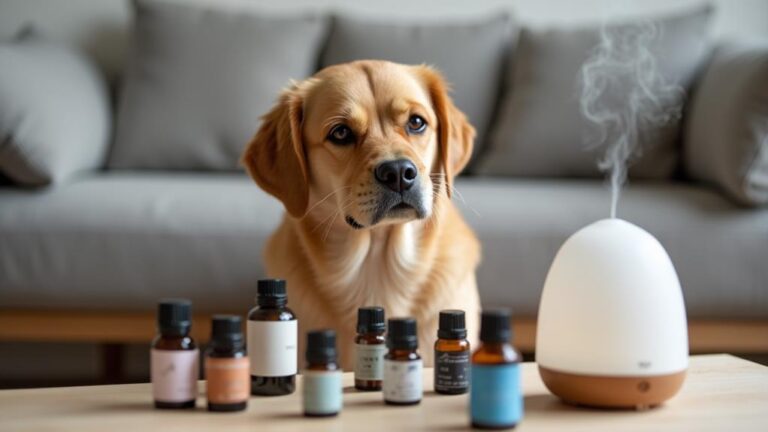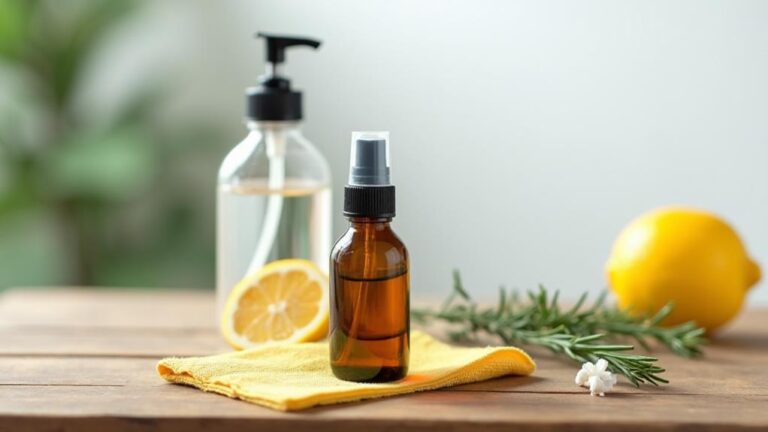When making soap, using essential oils can be a great way to create unique fragrances and skin benefits, such as adding tea tree oil for its antimicrobial properties. However, you need to be careful when incorporating essential oils into your soap recipe, as they can be potent and potentially irritating to the skin. To avoid any issues, it's vital to understand how to use essential oils correctly. By following a step-by-step process, you can guarantee that your soap not only smells great but also provides the desired skin benefits without causing any adverse reactions – but what are these steps exactly?
Key Takeaways
- Handle essential oils with care to avoid skin and eye irritation due to their high concentration.
- Store essential oils in a cool, dark place, away from direct sunlight and heat sources, to preserve quality and shelf life.
- Calculate the right amount of essential oils to add to soap recipes, considering oil ratios and fragrance profiles.
- Add essential oils at the right time, typically after the lye and oils have reached a temperature between 100°F and 120°F.
- Perform patch testing and sensitivity screening to identify potential skin irritants or allergens and adjust the essential oil concentration.
Choosing Essential Oils Wisely
When selecting essential oils for soap making, it's crucial to choose them wisely, pondering not just their fragrance but also their skin benefits, safety, and potential interactions.
You'll want to research essential oil profiles to understand the unique characteristics of each oil. This includes their chemical composition, therapeutic properties, and potential skin benefits. For example, lavender oil is known for its calming and soothing effects, while tea tree oil has antimicrobial properties that can help control acne.
To create complex and alluring scents, you'll also want to ponder scent layering. This involves combining multiple essential oils to create a unique fragrance profile.
For example, you might combine top notes like citrus or mint with middle notes like lavender or geranium, and base notes like patchouli or sandalwood. By understanding the different characteristics of each essential oil and how they interact with one another, you can create soap recipes that aren't only fragrant but also beneficial for the skin.
Understanding Safety Guidelines
When working with essential oils in soap making, you'll need to handle them carefully to avoid skin and eye irritation.
Essential oils are highly concentrated, so it's vital to take precautions when measuring, mixing, and blending them into your soap recipes.
Handling Essential Oils
Handling essential oils in soap making requires a thoughtful approach, taking into account their potent nature and potential risks.
You'll want to exercise caution when handling these concentrated oils to avoid accidents and guarantee a safe working environment.
When it comes to essential oil storage, you'll want to keep them in a cool, dark place, away from direct sunlight and heat sources.
This will help preserve the oil's quality and shelf life.
The ideal storage conditions are in airtight glass containers, tightly sealed and labeled.
It's also essential to check the oil's shelf life before use, as some essential oils can oxidize or degrade over time, which may affect their safety and effectiveness.
Typically, essential oils have a shelf life ranging from 1 to 3 years, depending on the specific oil and storage conditions.
Always check the supplier's guidelines for specific storage and shelf life recommendations.
Skin Irritation Risks
You've taken the first step in working with essential oils by understanding how to handle them safely, and now it's time to weigh the potential risks they pose to skin health.
Essential oils can be skin irritants, causing allergic reactions or sensitization risks in some individuals. When used in soap making, it's vital to ponder the concentration of essential oils and their potential impact on skin.
Skin irritation can manifest as redness, itching, or burning sensations.
Allergic reactions can be more severe, causing blisters, rashes, or even anaphylaxis.
Sensitization risks occur when an individual becomes increasingly sensitive to an essential oil, leading to more severe reactions over time.
To mitigate these risks, you should perform patch tests on a small group of people before releasing your soap products to the market.
This involves applying a small amount of soap to a discrete area of skin and monitoring for any adverse reactions.
You should also ponder using gentle, skin-friendly essential oils and follow recommended usage rates to minimize the risk of skin irritation and allergic reactions.
Calculating Essential Oil Amounts
Calculating the right amount of essential oils to add to your soap recipe is crucial in achieving the desired scent, skin benefits, and safety standards.
You'll want to ponder the oil ratios of your essential oils, as some can be quite potent. A general rule of thumb is to use 1-3% essential oils in your soap recipe. This means that for every pound of soap, you'll add 1-3 teaspoons of essential oils.
When calculating the amount of essential oils, ponder the fragrance profiles you're aiming for. If you're using a single-note essential oil like lavender, you may want to use a higher percentage.
However, if you're blending multiple essential oils, you'll want to use a lower percentage to avoid overpowering the scent. You can use an online calculator or create your own spreadsheet to make the calculations easier.
It's also important to note that some essential oils, like peppermint and eucalyptus, are quite strong and may require smaller amounts.
Always check the recommended usage rates for each essential oil and adjust accordingly to guarantee a safe and effective soap recipe.
Selecting Compatible Soap Bases
When choosing a soap base for your essential oil soap recipe, compatibility is key to ensuring a harmonious blend of ingredients.
You'll want to ponder base choices that complement the fragrance profiles you're aiming for. For example, if you're using a strong, pungent essential oil like peppermint or eucalyptus, a gentle, moisturizing soap base like olive oil or coconut oil may help balance out the scent.
On the other hand, if you're using a delicate, floral essential oil like lavender or chamomile, a soap base with a higher pH level, like palm oil or shea butter, may enhance the fragrance.
Reflect on the skin type and preferences of your target market when selecting a soap base. For instance, sensitive skin may benefit from a base with soothing ingredients like aloe vera or green tea.
Ultimately, the right soap base will depend on the specific essential oil you're using and the fragrance profile you're aiming for.
Blending Essential Oils Effectively
Blending essential oils effectively requires a deep understanding of their individual properties and how they interact with each other.
When blending, you'll want to ponder the unique olfactory profiles of each oil, including their top, middle, and base notes. This will help you create harmonious fragrance layers that complement each other. Top notes provide the initial scent, middle notes add depth, and base notes linger longest.
By balancing these notes, you can create complex and alluring blends.
When selecting essential oils to blend, ponder their individual characteristics, such as their scent intensity, stability, and potential skin benefits. Some oils, like lavender and chamomile, are calming and soothing, while others, like peppermint and eucalyptus, are invigorating and revitalizing.
By understanding these differences, you can craft blends that not only smell amazing but also provide specific benefits for the skin. Experiment with different ratios and combinations to find the perfect blend for your soap making needs.
Keep in mind that blending is an art, and it may take some trial and error to achieve the desired result.
Adding Essential Oils to Soap
Adding Essential Oils to Soap
Your carefully crafted essential oil blend is now ready to be incorporated into your soap making project.
When adding essential oils to soap, it is vital to take into account the fragrance profile you want to achieve and the soap recipes you're using. Essential oils can greatly impact the final product, so it is paramount to get it right.
Some key considerations when adding essential oils to soap:
- Calculate the right amount: Determine the amount of essential oil to add based on the recipe and the strength of the fragrance you want to achieve.
- Take into account the soap recipe: Different soap recipes may require different amounts of essential oil, so adjust accordingly.
- Add at the right time: Typically, essential oils are added to the soap mixture after the lye and oils have reached a temperature between 100°F and 120°F.
- Mix well: Verify the essential oil is fully incorporated into the soap mixture to achieve an even fragrance profile.
Testing Soap for Irritation
How can you guarantee the soap you've carefully crafted with essential oils won't irritate the skin of those who use it?
To verify your soap is safe for use, it's vital to conduct patch testing and sensitivity screening.
Start by selecting a small group of volunteers with diverse skin types to participate in your patch test. Apply a small amount of soap to a discreet area of their skin, such as behind the ear or on the wrist, and wait 24 to 48 hours for any adverse reactions.
Monitor the area for redness, itching, or irritation. If any reaction occurs, reassess the essential oil concentration and adjust as needed.
Sensitivity screening involves testing individual essential oils for potential skin irritants. Research the specific essential oils you're using to identify any known skin irritants or allergens.
If you're unsure, perform a patch test on a small area before adding the essential oil to your soap recipe. By conducting these tests, you can confidently confirm your soap is gentle and safe for use on various skin types.
This step is vital in creating a high-quality, skin-friendly soap product.
Frequently Asked Questions
Can I Use Essential Oils on Sensitive Skin Soap Recipes?
When creating soap for sensitive skin, you'll want to choose essential oils carefully, considering skin types that may react to certain oils, and dilute them to minimize sensitive reactions for a soothing experience.
Are Essential Oils Suitable for Soap Making With Kids?
Are you considering a fun, creative activity with kids that's also safe? When choosing essential oils for soap making with kids, prioritize kid safety by selecting gentle, child-friendly oils and supervising child involvement closely.
Do Essential Oils Affect Soap Color or Texture?
When you work with essential oils, you'll find that they can indeed affect soap color and texture due to their unique oil properties and scent strength, potentially causing discoloration or altering lather.
Can I Add Essential Oils to Already Made Soap?
You can add essential oils to already made soap through rebatching or oil infusion methods, allowing you to incorporate their therapeutic properties and fragrance into existing soap bars without compromising their quality or integrity.
Are Essential Oils Safe for Soap Making During Pregnancy?
During pregnancy, you're cautious with everything, like Sarah who avoided strong scents. When it comes to soap making, limits apply: some essential oils can compromise fetal safety, so you should choose gentle, pregnancy-safe options carefully.
Conclusion
By following these 7 steps, you'll tap into the full potential of essential oils in soap making and create a product that's nothing short of magical. You'll be crafting soap that's not just a cleansing tool, but a sensory experience that transports users to a world of tranquility and bliss. With patience, practice, and the right techniques, you'll be churning out soap that's a game-changer for skin care – and a true masterpiece of your craft.


